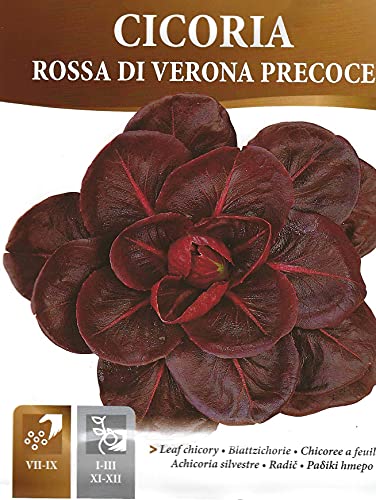Description
Chicory Rossa DI VERONA PRECOCE
Chicory Rossa DI VERONA PRECOCE this colourful variety is popular in Italy added to salads as a lettuce alternative with a more distinct flavour, vert slightly bitter. They can also be lightly blanched as a vegetable which removes any hint of bitterness. Will stand well into winter.
Cultivation For Chicory Rossa DI VERONA PRECOCE
1.Choose a location with well-draining soil and plenty of sunlight. Chicory grows well in various soil types but prefers fertile, loamy soil.
2. Sow seeds directly into the ground after the last frost date in your area. Plant seeds about 1/4 to 1/2 inch deep and space them 6 to 12 inches apart in rows that are about 18 inches apart.
3. Keep the soil consistently moist but not waterlogged. Water regularly, especially during dry periods, to ensure proper growth.
4. Once the chicory plants have grown a few inches tall, thin them to maintain proper spacing. This allows each plant to have enough room to grow and develop fully.
5. Remove weeds regularly to prevent competition for nutrients and space. Consider mulching to help retain soil moisture and control weeds.
6. Chicory Rossa di Verona Preco can be harvested when the heads are mature, usually around 85-90 days after planting. You can cut the heads at ground level or pull up the entire plant.
7. Store harvested chicory heads in a cool, dry place. They can also be stored in the refrigerator for several days.
8. Before planting, work in organic matter or a balanced fertilizer into the soil. Chicory doesn’t typically require heavy fertilization but benefits from nutrient-rich soil.
9. Chicory is tolerant of cooler temperatures and can thrive in both spring and fall. In warmer regions, it’s best to plant chicory in the fall for a winter harvest.
10. Keep an eye out for common pests like aphids, snails, and slugs. Regular inspection can help catch infestations early. Chicory is also generally resistant to most diseases, but proper air circulation and soil drainage can prevent potential issues.
11. Chicory Rossa di Verona Preco, known for its beautiful red leaves and slightly bitter flavor, thrives in conditions similar to other chicory varieties. However, each variety might have slightly different growing preferences, so it’s good to consult specific guidelines if available.
12. Consider planting chicory in succession every few weeks for a continuous harvest rather than all at once. This approach allows for a staggered yield.
13. If you want to save seeds for future planting, let some plants bolt (produce flowers) and go to seed. Collect the seeds once the flowers have dried, and store them in a cool, dry place for the next planting season.
14. Chicory, especially Rossa di Verona Preco, is versatile. Its slightly bitter taste works well in salads when mixed with other greens or lightly sautéed as a side dish. Some people enjoy its bitterness, while others prefer blanching or soaking the leaves in water to reduce bitterness before using them.
15. Some gardeners prefer blanching chicory to reduce its bitterness. This involves covering the plants or individual leaves to exclude light, typically a couple of weeks before harvesting. Blanching can be achieved by covering the plants with a pot, cardboard, or tying the outer leaves together. This process results in milder-tasting leaves.
16. Young leaves can be harvested for salads when they’re small and tender. Larger leaves, when the plant matures, can be used in cooked dishes like soups, stews, or sautés. Some people also enjoy chicory leaves in sandwiches or as a cooked side dish with garlic and olive oil.
17. In regions with mild winters, chicory can be overwintered for an early spring harvest. Protect the plants from severe frost with row covers or mulching to extend the growing season.
18. Chicory can benefit from being planted alongside other compatible plants like beans, peas, or herbs such as dill and mint. Avoid planting it near plants susceptible to similar pests or diseases to prevent potential issues.
19. Chicory leaves can be versatile in the kitchen. Try experimenting with different cooking methods (steaming, grilling, roasting) to explore and appreciate its flavors.
20. Always opt for high-quality seeds from reputable sources to ensure better germination rates and healthy plant growth.
21. Pay close attention to how your chicory plants respond to the specific conditions in your garden. Adjust watering, fertilizing, and other care practices based on their needs.









Reviews
There are no reviews yet.